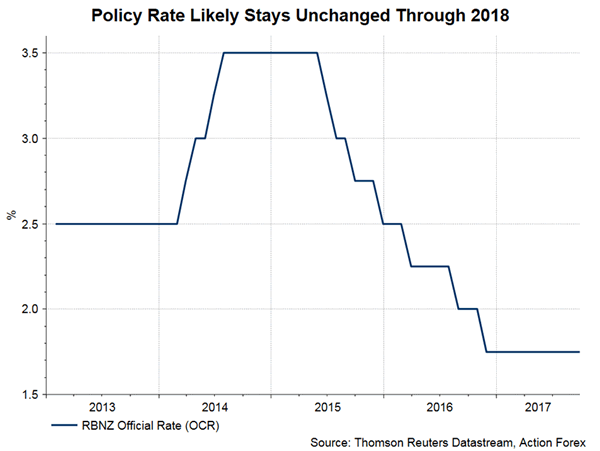As widely anticipated, RBNZ left the OCR unchanged at 1.75% in September Policymakers downgraded the domestic growth outlook and suggested that the accommodative monetary policy would stay for a ‘considerable period’. Thanks to the recent decline in New Zealand, driven by heightened political uncertainty, RBNZ tweaked its warning over currency strength. It noted that a lower exchange rate would "would help" raise tradables inflation. We expect RBNZ to keep the policy rate unchanged for the rest of the year, and likely through 2018.
Policymakers turned less optimistic over the economic developments. As mentioned in accompanying statement, ‘construction was weaker than expected’ and ‘growth is projected to maintain its current pace going forward, supported by accommodative monetary policy, population growth, elevated terms of trade, and fiscal stimulus’. This is contrasted with October’s statement that ‘growth is expected to improve going forward, supported by accommodative monetary policy, strong population growth, an elevated terms of trade, and the fiscal stimulus outlined in Budget 2017’. On inflation, RBNZ attributed the ongoing decline in headline inflation to the ‘volatility in tradable inflation’. In August, it suggested that it was due to the dissipation of’ higher fuel and food prices’. The view on the housing market stayed largely unchanged, despite the weaker housing price since the last forecast.
New Zealand dollar dropped modestly since the last meeting on August 10. NZD fell -0.74% against USD and -0.27% against AUD. Yet, the central bank appeared less concerned about the currency strength. As noted in the statement, the ‘trade-weighted exchange rate has eased slightly’ during the inter-meeting period. It, however, affirmed that ‘a lower New Zealand dollar would help to increase tradables inflation and deliver more balanced growth’. This marks a more relaxed language when compared to the August one, when the central bank warned that ‘the trade-weighted exchange rate has increased since the May Statement, partly in response to a weaker US dollar. A lower New Zealand dollar is needed to increase tradables inflation and help deliver more balanced growth’.

On the monetary policy outlook, RBNZ noted that it would ‘remain accommodative for a considerable period. Numerous uncertainties remain and policy may need to adjust accordingly’. One of the key uncertainties is the new government. The general election held last week resulted in a hung parliament. Although the National Party got most seats in the parliament, it fails to secure over 61 seats form a majority government by itself. A minority government appears less likely than in the previous term as the number of small parties entering the parliament has reduced this time. It appears quite possible for a coalition government of Nationals and NZ First. It is a real risk that the reforms proposed by the populist NZ First would drag the economic growth outlook, prolonging the accommodative monetary policy. We expect RBNZ to keep the policy rate unchanged for the rest of the year, and likely through 2018.














